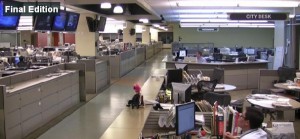Newspaper layoffs are now being paired with salary cuts as publishers seek to avoid running up even larger body counts. McClatchy’s announcement early this week that it will cut 1,600 jobs is already claiming victims at the publisher’s largest papers.
The Miami Herald will eliminate 175 jobs and cut the pay of salaried employees by 5% to 10%. The publisher will also require one-week unpaid furloughs beginning in April. The cuts include 33 full-time and eight part-time newsroom positions. Altogether, the move slashes 19% of the Herald‘s workforce. Other cost-cutting mesures include leasing some of the paper’s office space, cutting trim size and eliminating an international edition. McClatchy put the Herald up for sale in December, but there have been no reported takers so far.
Another McClatchy paper, the Kansas City Star, will cut its workforce by 15%, or 150 employees, in line with corporate guidelines. Pay will also be reduced by between 5% and 10% and management bonuses will be eliminated. With the latest cuts, the Star will have hacked 325 jobs over the last nine months, or about a quarter of its workforce.
Two weeks ago, the Denver Post lost its biggest competitor. Now it’s picked up the printing work for a nearby daily. The Fort Collins Coloradoan said it will outsource printing and delivery to the Denver Newspaper Agency starting May 12 and lay off 48 people. The agency was created to handle business operations for the Post and the now-defunct Rocky Mountain News. The Coloradoan said the speed of the agency’s new presses will enable it to move printing operations 50 miles away and still maintain current delivery schedules.
The union representing employees at the Modesto Bee just voted to accept a pay reduction, but the paper will lay off 11 employees anyway. It could have been worse: Management was ready to cut 10 more jobs without union concessions. Wages for surviving employees will be cut by between 2% and 10% and employees may also be required to take one-week unpaid vacations later this year. The nearby San Luis Obispo Tribune will lay off three employees at the end of the month and cut four more positions as it outsources some financial functions to the Fresno Bee. The cuts will reduce the workforce to 163 people, down about 17% from a year ago.
Members of the California Media Workers Guild, Local 39521 could vote as early as today on contract concessions intended to keep the San Francisco Chronicle afloat – at least for now. The provisional agreement reached late Monday involves terms that are usually antithetical to labor unions. Basically, management will get the authority to lay off employees without regard to seniority. Other concessions include reductions in vacation time and leave, expansion of the work week from 37.5 hours to 40 and expanded management ability to subcontract work. The Chronicle has put a gun to the union’s head, saying it would need significant concessions just to keep the paper operating. Even then, owner Hearst Corp. is on record saying that more than 30% of Guild-represented employees will be let go. The tentative contract provides for two weeks’ pay for each year of service for laid-off workers.
The Twitter microblogger who goes by the handle @themediaisdying comes out of the shadows to write about opportunity in the industry. If you care about the future of media, you need to follow Paul Armstrong’s tweets. His opinion piece in BusinessWeek is quite the contrast to his online persona. “Nothing has gone ‘wrong,’ per se,” he writes. “It is simply a changed balance of power. Creator and consumer are no longer tied to the other.” Armstrong says mainstream media can carve out a profitable place in the new world by focusing on what readers want rather than what they can deliver. “Media, get into our daily routines any way you can and make sure you stay there,” he writes. “Once there, cultivate additional income through advertising that adds to, rather than detracts from, the reason we came to you.” It all sounds good, but the devil is in the details. Even if media organizations can reinvent themselves as reader-driven entities, it’s unlikely most can do it amid the current environment of cutbacks and despair. But we surely appreciate the message of hope.


 It depends on the location. Areas of Europe that are well wired for the Internet and have robust wireless infrastructures, like the Nordic region, will probably see the need for newspapers decline more quickly than those that charge high fees for Internet access or do not have affluent populations. Eastern Europe, in contrast, will probably be a fairly robust market for newspapers for some time. Some cultures are also more invested in the newspaper model, as is the case in the UK. In general, Europe will discard print newspapers more slowly than the US because traditions are more embedded and, in some cases, government subsidies will keep print publications afloat. France is an example of that.
It depends on the location. Areas of Europe that are well wired for the Internet and have robust wireless infrastructures, like the Nordic region, will probably see the need for newspapers decline more quickly than those that charge high fees for Internet access or do not have affluent populations. Eastern Europe, in contrast, will probably be a fairly robust market for newspapers for some time. Some cultures are also more invested in the newspaper model, as is the case in the UK. In general, Europe will discard print newspapers more slowly than the US because traditions are more embedded and, in some cases, government subsidies will keep print publications afloat. France is an example of that.



 Mark Potts
Mark Potts 





